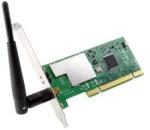
It seems like only yesterday that there was no such thing as wireless networks. Networking computers together involved hubs, routers, switches, and a whole lot of Ethernet cables. Today, computers can be linked together without wires and cables through the use of wireless networking technology.
Wireless networking technology has evolved quickly, with each generation becoming faster and better performing. However, in a market with three standards in operation, it's making it confusing for many who want to start their own home network.
Currently, there are three different 802.11 standards in use today. The term "802.11" refers to the working group of the larger Institute of Electrical & Electronics Engineers (IEEE), who is an international group responsible for publishing standards for electronic technologies. When looking at hardware for a wireless network, there will also be a letter after the 802.11 designation, either b, g, or a. This letter indicates which wireless network standard the hardware is based on, which helps differentiate what kinds of features and performance the wireless technology will provide.
When buying into wireless network technology, there are different standards to choose from. A breakdown of these is below.
802.11b
802.11b is what started the wireless network revolution in 1999. Since it has been around the longest, it's the most common wireless network technology in use today.
802.11b technology is the least expensive of the group. It has a theoretical speed of 11Mbps (mega-bits per second), which is fast enough for most users. It also sports a wide coverage area of around 150 to 300 feet. The 'b' standard operates in the 2.4GHz band, which is somewhat suceptable to forms of common radio interference from other household devices like cordless phones and microwave ovens.
Except in instances where very large files will be transferred from computer to computer within a network, or when there will be many people using the network at the same time, 802.11b is a great performing and economical choice.
802.11g
802.11g emerged a few years later as an extension of the 802.11b standard. It operates on the same frequency band, but with an increased theoretical speed of 54Mbps, which makes transferring large files much faster over a wireless network. Also, the increased bandwidth also helps in networks with many simultaneous users.
802.11g and b are compatible with each other, which allows both types of devices to work together on the same network. If 802.11g is selected, devices with g capability will work at faster speeds, but will slow in speed to be compatible with the max speed of 802.11b when necessary.
802.11a
802.11a and 802.11g, on paper, are very similar in speed and performance. However, the 802.11a standard operates on higher frequencies (5 GHz band) than the 802.11b/g standard. This is desirable in high-traffic areas where there are too many users in the b/g frequency range, and interference from other household devices. Since the 5 GHz band is less crowded, 802.11a is dramatically faster at moving data than either b or g. However, the effective range of the network is not as good, which requires you to be positioned closer to the wireless access point.
Be aware that 802.11a and 802.11b/g are not compatible standards; all sending and receiving equipment in the network must be 802.11a capable. More often than not, computers that ship with wireless network technology built in typically do not support 802.11a.
But I've Seen Claims of 108Mbps?
There are many wireless networking technologies that claim faster speeds than what the technology is capable of. Manufacturers have taken the liberty to improve and massage current standards to make higher performance equipment while still maintaining compatibility to existing standards.
It is important to understand that this equipment will provide no benefits unless that brand's corresponding devices are on every sending and receiving device in the network, which indicates that it's a better way for manufacturers to ensure users buy all of their networking equipment from them. Remember, the potential gains of these enhancements will not be noticeable for most web-based tasks like gaming and browsing.




